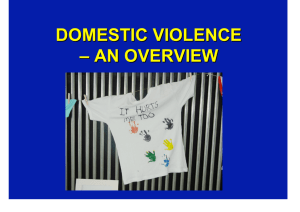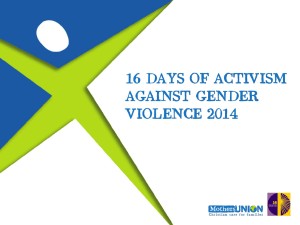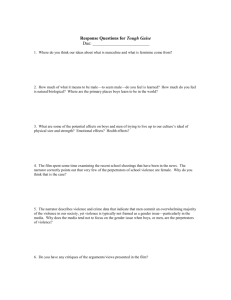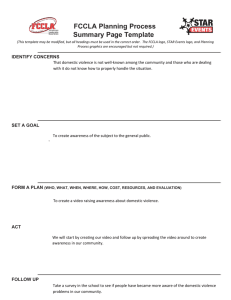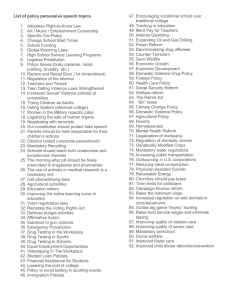Goals of Government Intervention in Domestic Violence Cases
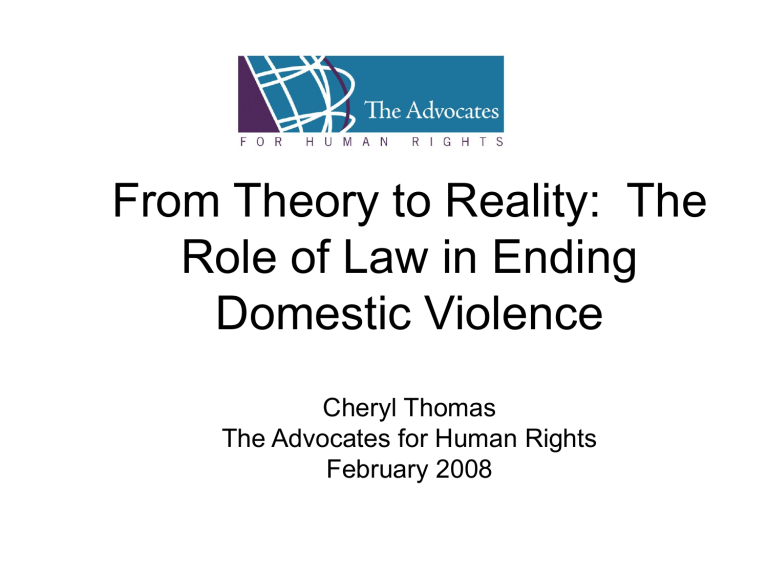
From Theory to Reality: The
Role of Law in Ending
Domestic Violence
Cheryl Thomas
The Advocates for Human Rights
February 2008
StopVAW
Original Goals of Laws and
Government Intervention in
Domestic Violence Cases
• Safety and security for the abused party and her children
• Accountability for the perpetrator of the violence
• Public message: Zero Tolerance for Violence
Unique Characteristics of Domestic
Violence Cases That Legal Reform
Must Address
• Domestic violence is hidden and underreported
• Assaults are often repeated over and over again in a woman’s life
• Involves pattern of conduct of offender exerting control over victim
• Low-level injuries are common
• Marital or intimate relationship makes victim uniquely vulnerable to further abuse, threats
• Fear and vulnerability often lead to victim recantation
Highlights of Criminal Law Reform in the
United States That Acknowledge Unique
Characteristics of Domestic Violence
1.
Changes to threshold standards for arrest
2.
Requirement that police write report at scene of assault
3.
Increased penalties for repeat offenders
(Enhancement)
4.
Pre-sentence investigation requirements and specialized domestic violence danger assessment tools
Changes to Threshold Standards for Arrest
Probable Cause Arrests
“. . . A peace officer may arrest a person anywhere without a warrant, including at the person’s residence, if the peace officer has probable cause to believe that within the preceding 12 hours the person has committed domestic abuse, as defined in section 518B.01, subdivision 2. The arrest may be made even though the assault did not take place in the presence of the peace officer.”
Minnesota. Stat. 629.341 (subd. 1)
Requirement That Police Write
Report at Scene of Assault
• Addresses reality that police do not always hold offender accountable for domestic assault
• Creates public record of domestic assault that previously was hidden
• Facilitates prosecution of domestic assault
Increased Penalties for Domestic
Violence Offenders
• Law allows increased penalties for domestic violence crimes – even if crimes all involve low-level injuries
• Reflects repeat nature of offense
• Reflects community priority/public interest in ending domestic violence
• Laws in Albania and Macedonia reflect such change
Minnesota Statute 609.2242
• Subd. 2. Gross misdemeanor.
Whoever violates subdivision 1 within ten years of a previous qualified domestic violence-related offense conviction or adjudication of delinquency against a family or household member as defined in section
518B.01, subdivision 2 , is guilty of a gross misdemeanor and may be sentenced to imprisonment for not more than one year or to payment of a fine of not more than $3,000, or both.
Pre-sentence Investigation Requirements and Specialized Domestic Violence Danger
Assessment Tools
Risk Assessment Requirement in
Minnesota Statute 609.72
• In making a decision concerning pretrial release conditions of a person arrested for domestic abuse, harassment, violation of an order for protection, or violation of a domestic abuse no contact order, the judge shall review the facts of the arrest and detention of the person and determine whether: (1) release of the person poses a threat to the alleged victim, another family or household member, or public safety; or (2) there is a substantial likelihood the person will fail to appear at subsequent proceedings.
Domestic Violence Laws with
Civil Order for Protection
Provision
• New remedy with core provision granting courts authority to order batterers out of the home
Original Goals of Order for
Protection Provisions
• Ensure that person enduring violence is not forced to leave the home
• Provide an alternative to burdensome criminal procedures
• Provide an alternative to divorce
• Provide access to relief through justice system in quick and efficient manner
• Provide victim relief through legal system which she can control
30 Years of Reform in Order for
Protection Laws: Highlights
• Criminalization of violation of an Order for Protection
• Remedies addressing economic factors which impede victims from seeking OFP (financial support, child maintenance)
• Reform related to custody of children
• Reform to include intimate partners and others (not just spouses)
Criminalization of Violations of
Orders for Protection
• Important to ensure accountability of violent offender and provide “teeth” for Order for Protection
• Several laws in CEE/FSU criminalize violation – Albania,
Serbia, Georgia
• Minnesota includes violation of OFP as enhancable offense, no violence necessary
Remedies Addressing Economic
Factors
• Important to facilitate victims’ ability to live separately from violent offenders
• Can include restitution, child support, rent, car payment, insurance payment, payment of medical expenses
• Several laws include provisions granting court authority to order such payments: Albania, Bosnia, Kosovo,
Kyrgyzstan
Child Custody in Domestic Violence
Cases
• American Bar Association recommends and several states in U.S. have enacted statutory presumptions that it is not in a child's best interest to be in the custody of a domestic violence perpetrator
• Several new laws in CEE/FSU contain provisions on this issue. Albanian example: court may prohibit perpetrator from seeing victim’s child. Article 10 (e)
• Georgian example: Court shall consider that custody with violent parent is “prejudicial” to child. Article 14 (3)
Victim-Centered Legal Reform
• “[The] law should be re-configured to put the victim’s experience and the victim’s need for protection at the centre of the law, transforming social ideas about blame of victims for the assaults they suffer.”
» Making Rights a Reality: The Duty of States to
Address Violence Against Women , Amnesty
International (2004)
